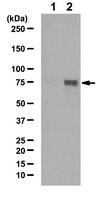07-1347 Sigma-AldrichAnti-phospho-STAT3 (Tyr68) Antibody
Detect phospho-STAT3 (Tyr68) using this Anti-phospho-STAT3 (Tyr68) Antibody validated for use in WB.
More>> Detect phospho-STAT3 (Tyr68) using this Anti-phospho-STAT3 (Tyr68) Antibody validated for use in WB. Less<<Produits recommandés
Aperçu
| Replacement Information |
|---|
Tableau de caractéristiques principal
| Species Reactivity | Key Applications | Host | Format | Antibody Type |
|---|---|---|---|---|
| H, M, R, B, Po, Xn, Ch | WB | Rb | Affinity Purified | Polyclonal Antibody |
| References |
|---|
| Product Information | |
|---|---|
| Format | Affinity Purified |
| Control |
|
| Presentation | Purified rabbit polyclonal in buffer containing 0.1 M Tris-Glycine (pH 7.4), 150 mM NaCl with 0.05% sodium azide. |
| Quality Level | MQ100 |
| Applications | |
|---|---|
| Application | Detect phospho-STAT3 (Tyr68) using this Anti-phospho-STAT3 (Tyr68) Antibody validated for use in WB. |
| Key Applications |
|
| Physicochemical Information |
|---|
| Dimensions |
|---|
| Materials Information |
|---|
| Toxicological Information |
|---|
| Safety Information according to GHS |
|---|
| Safety Information |
|---|
| Storage and Shipping Information | |
|---|---|
| Storage Conditions | Stable for 1 year at 2-8°C from date of receipt. |
| Packaging Information | |
|---|---|
| Material Size | 100 µg |
| Transport Information |
|---|
| Supplemental Information |
|---|
| Specifications |
|---|
| Global Trade Item Number | |
|---|---|
| Référence | GTIN |
| 07-1347 | 04053252632075 |
Documentation
Anti-phospho-STAT3 (Tyr68) Antibody FDS
| Titre |
|---|
Anti-phospho-STAT3 (Tyr68) Antibody Certificats d'analyse
| Titre | Numéro de lot |
|---|---|
| Anti-phospho-STAT3 (Tyr68) - 2300030 | 2300030 |
| Anti-phospho-STAT3 (Tyr68) - 2361987 | 2361987 |
| Anti-phospho-STAT3 (Tyr68) - 3684690 | 3684690 |
| Anti-phospho-STAT3 (Tyr68) - NRG1901299 | NRG1901299 |
| Anti-phospho-STAT3 (Tyr68) -2817718 | 2817718 |
Brochure
| Titre |
|---|
| New Products: Volume 3, 2012 |
Informations techniques
| Titre |
|---|
| JAK/STAT Signaling Research Focus |







